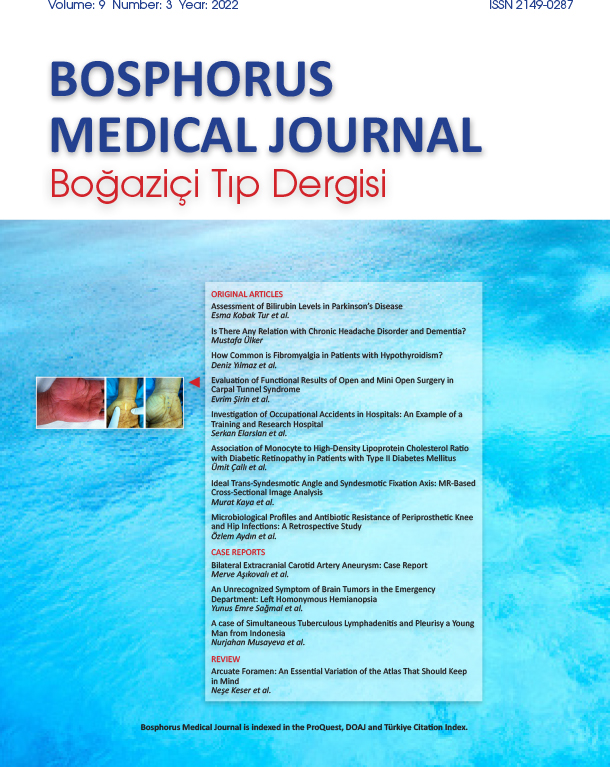Volume: 4 Issue: 2 - 2017
| ORIGINAL RESEARCH | |
| 1. | Mobbing Behavior and Two Public Hospitals Survey for Employees Eylem Yılmaz, Selma Söyük doi: 10.15659/bogazicitip.17.05.648 Pages 55 - 61 INTRODUCTION: The research has been planned in the nature of comparative descriptive with the aim of determining the circumstances of encounter with mobbing behavior of State Hospitals health staffs and assistants. METHODS: All health care workers and assistants working in public hospital and Oral Health Care Center are in this research sample on between 04 November 2012 and 30 May 2013. A questionnaire form consisting of 3 parts was used so as to designate. RESULTS: In the study it was seen that all employees in the public hospital and oral and dental health center were exposed to mobbing behavior at least once and met with mobbing behavior. DISCUSSION AND CONCLUSION: Consequently, mobbing behavior is frequently seen especially in the public institutions serving as health care service. |
| 2. | Drug İntoxication At Emergency Service And Serum Drug Level Relationship Servan Kara, Zeynep Mine Kara, Arzu Denizbaşı Altınok, Özge Ecmel Onur doi: 10.15659/bogazicitip.17.05.669 Pages 62 - 67 INTRODUCTION: Intoxications due to drugs and other substances are still an important health issue. In this study we want to investigate the correlation between serum drug levels and demographic properties of patients who present to the emergency department with suicide attempts with drugs. METHODS: Patients over 18 years of age who presented to emergency department (ED) with drug intoxication due to suicide attempt and whose blood drug levels could be obtained are included in our study. Age, gender, vital signs on presentation are all recorded. Two major groups were formed, patients who are discharged and who were admitted to intensive care unit (ICU). By this data, correlation between the drug levels and clinical progress is observed. RESULTS: Between February 2013 and August 2013, 60 patients who met our inclusion criteria were studied. 71,7% were female (N=43), %28,3 were male (n=17). Mean age was 26.88±6.2. 38 patients (63,3%) were monitored in ED for 6 to 24 hours and were discharged. 22 patients(36,7 %) needed ICU admission. The higher blood levels of tricyclic antidepresants (TCA) correlated with higher incidence of ICU admission. Paracetamol levels in both groups were nearly same, and these levels proved no importance in ICU admission. And, we also observed the correlation between the drugs and vital signs in our study. In addition to this, The group who had TCA, had statistically significant low mean arterial pressures, faster heart rate and faster respiratory rate. DISCUSSION AND CONCLUSION: We conclude that clinical decision making of patients with unknown or undetermined amounts of drug intake should be made not only according to their blood drug levels but also to their clinical states and their vital signs especially mean arterial pressure (MAP), heart rate. |
| 3. | Effects of Fentanyl and Morphine Combined with Intrathecal Levobupivacaine in Elective Cesarean Sections Yıldız Yiğit Kuplay, Dilek Subaşı, Ahmet Yıldırım, Güldem Turan doi: 10.15659/bogazicitip.17.05.675 Pages 68 - 76 INTRODUCTION: This study was conducted with the aim of evaluating the effects of fentanyl and morphine used in addition to intracethecal levobupivacaine in combined spinal-epidural anesthesia (CSEA) in cesarean section operations. METHODS: After approval of the hospitals ethical board and written approvals of the patients, 40 pregnant women undergoing elective cesarean section delivery, aged 18 to 45, ASA group I-II, in whom regional anesthesia is not contraindicated were included. Included patients (n: 40) were randomized into two groups with first group LF (n: 20) to receive 7,5 mg %0.5 levobupivacaine + 25 mcg fentanyl and second group LM (n: 20) to receive 7,5 mg %0.5 levobupivacaine + 100 mcg morphine. Patients motor block initiation time, motor and sensory block levels at minutes 1, 3, and 5, blood pressure and heart rates, time needed for sensory block to reach T4, time needed for motor block to reach highest level, highest levels of motor and sensory block, time of first required analgesic, motor block reversal time, intrathecal injection to delivery and intrathecal injection to end of operation time, blood pressure, heart rate, and spO2 levels of the mother every 5 minutes, umbilical vein blood gases of the baby, Apgar scores at minutes 1 and 5, side effect profile (hypotension, nausea-vomiting, bradycardia, ephedrine requirement, itching, postoperative headache), peroperative and postoperative VAS scores (VAS score 0 for no pain, 5 for moderate, 10 for severe pain) were recorded. RESULTS: In both groups all individualsskin incision VAS score was accepted to be 0. When groups were compared no significant difference was found in uterine incision and postoperative 30 min VAS scores. However a significant difference was observed between peritoneal closure and postoperative 60 min VAS scores of the groups (p<0.05). In peritoneal closure measures Group LM VAS scores concentrated around 3,4,5 while Group LF had a significant amount of patients at 0 score. In postop 60 min measures Group LM patients had a large portion at VAS score 0 while Group LF had patients distributed at values 0, 2, 3, 5, and 6. Group LFs time needed to reach highest motor block mean was significantly higher than that of Group LM. Group LMs time of first required anesthetic mean was significantly higher than that of Group LF. Group LMs sensory block levels were distributed rather equally among T2, T3 and T4 while in Group LF there was a concentration at levels T2 and T4. There was no significant difference between groups concerning seen side effects. DISCUSSION AND CONCLUSION: Levobupicavaine is a local anesthetic that can be used safely in cesarean section of pregnant women due to its low side effect profile in cardiovascular and central nervous systems. 25 µg fentanyl and 100 µg morphine added to %0,5 levobupivacaine has a low side effect profile in the mother and the baby, and results in a shorter time motor blockage than previous studies. Morphine added to levobupivacaine provides a longer analgesia duration and reduced analgesia requirement in the postoperative period. |
| 4. | Pressure Pain Threshold in Musculoskeletal Disorders Özbil Korkmaz Gürel, Aslıhan Taraktaş, Duygu Kurtuluş, Cengiz Bahadır doi: 10.15659/bogazicitip.17.05.676 Pages 77 - 83 INTRODUCTION: Pain is the most significant symptom in musculoskeletal disorders. General hypersensitivity to pain is often associated with conditions of chronic pain. In this study we compared pain degrees of different musculoskeletal disease groups by pain pressure threshold and visual analog scale. METHODS: Patients diagnosed with ankylosing spondylitis (n=34), fibromyalgia (n=30), myofascial pain syndrome (n=33), osteoporosis (n=34), generalized osteoarthritis (n=34) and rheumatoid arthritis (n=34) and healthy subjects (n=30) were included in the study. Beck depression inventory was used for psychological evaluation. Visual analog scale (VAS) was used to quantify clinical pain. PPT measurements made from the areas that generally not showing involvement of disease: at middle deltoid, middle ulna, hypothenar eminence, thumb, mid-tibia, and quadriceps femoris. RESULTS: VAS score for clinical pain ranged from 4.76±3.15 in ankylosing spondylitis to 7.44±2.42 in fibromyalgia. Fibromyalgia consistently had the lowest PPT across all sites of measurements indicating increased pain sensitivity. Myofascial pain syndrome and ankylosing spondylitis were the only diseasesthat did notshow greatersensitivity to pain compared to healthy controls. Osteoporosis patients also reported an average clinical pain of 6.09±3.23 on VAS, and showed general tenderness regardless of presence of verified fractures. Overall, female gender, advanced age, depression and NSAID use correlated with lower PPT DISCUSSION AND CONCLUSION: The level of pain sensitivity may provide a clue regarding the mechanism and treatment options of musculoskeletal disorders. |
| 5. | Correlation Between Pulse Pressure and Urinary Albumin Excretion in Type 2 Diabetic Patients without Microalbuminuria Elif Dizen Kazan doi: 10.15659/bogazicitip.17.05.682 Pages 84 - 88 INTRODUCTION: Microalbuminuria is the first clinically detectable stage of diabetic nephropathy and a risk factor for cardiovascular diseases. Also increased pulse pressure is regarded as a cardiovascular risk factor. In this study we aimed to investigate the correlation between urinary albumin excretion and pulse pressure in type 2 diabetic patients whom urinary albumin excretion did not reach to microalbuminuria level. METHODS: All type 2 diabetic patients were retrospectively analyzed who come for outpatient control between January 2015 and May 2016. Patients have a urinary albumin excretion lessthan 30 mg/24h were included to study.First registrations of all patients were studied in order to prevent repeated recordings. Patients were divided into three groups according to pulse pressure as; ≤46 mmHg, between 46-56 mmHg and ≥56 mmHg. Groups were compared in terms of urinary albumin excretion. RESULTS: Totally 147 patients were included the study; %70,1 (n: 103) were women and %29,9 (n: 44) were men. There were no differences between pulse pressure groups regarding to fasting plasma glucose, HbA1c, totally cholesterol, LDL-cholesterol, HDL-cholesterol, triglyserides, urea and creatinin levels(respectively p: 0,06, p: 0,1, p: 0,8, p: 0,7, p: 0,1, p: 0,6, p: 0,2 ve p: 0,09). The mean urinary albumin excretion was 6.92 ± 4.2 mg / 24 hours in the group ≤46 mm Hg, 11.15 ± 7.7 mg / 24 h in the group between 46-56 mmHg and 15 31 ± 5.8 mg / 24h in the group with the highest pulse pressure. There was a statistically significant positive correlation between urinary albumin excretion rates and pulse pressure groups (P <0.0001, r: 0,458). DISCUSSION AND CONCLUSION: Our study shows that urinary albumin excretion increases with the increase in pulse pressure in diabetic patients without microalbuminuria. This finding may be a risk factor for microalbuminuria development. Further studies are needed to investigate the effects of pulse pressure on diabetic nephropathy development. |
| 6. | Epistaxis in Emergency Room: Is Routine Blood Work Always Necessary? Sinem Doğruyol, Mehmet Fatih Korçak, Çiğdem Özpolat, Arzu Denizbaşı doi: 10.15659/bogazicitip.17.05.709 Pages 89 - 94 INTRODUCTION: Patients who applied to the emergency room of a tertiary hospital with epistaxis were evaluated in this study in terms of etiological, clinical and demographical characteristics. Our aim is to determine the value of routine laboratory tests in enlightening the etiology of epistaxis. METHODS: Between January 2015-June 2015, above 18 years old patients who were diagnosed with epistaxis in the emergency room were retrospectively reviewed from patient charts. Traumatic epistaxis cases were not included in the study. Patients were analzed in terms of age, sex, comorbidities and medications that may lead to bleeding, vital parameters and blood tests. RESULTS: The study consisted of 100 patients (52 male, 48 female) and the average age was 58,22±16,76. Median systolic blood pressure was 147±31,39, while median diastolic pressure was 88,38±20,12. Hypertension (59%), diabetes mellitus (16%), malignancy (6%), chronic renal failure (3%) and Glanzman disease were the comorbidities of the patients. Thirty three of the cases with a diagnosis of chronic hypertension were also vitally hypertensive at the admission of the emergency room. International normalized ratio (INR) was elevated in four of these patients and one of them was using warfarin sodium which was statistically significant (p=0.022). Medications that may lead to bleeding were warfarin sodium (11%), acetylsalicylic acid (%26) and clopidogrel (%6). Low hemoglobin level and elevated INR was seen in patients with a history of malignancy (p<0.005). DISCUSSION AND CONCLUSION: Hypertension is an etiological factor in epistaxis with increased incidence related to age. Hypertension alone is generally sufficient to explain the etiology of epistaxis. We believe that additional laboratory tests may not be necessary to determine the etiology of epistaxis in patients which have a diagnosis of chronic hypertension and are vitally hypertensive at the same time. |
| CASE REPORT | |
| 7. | Clay Shovelers Fracture: Case Report Serdar Özdemir, Gökhan Aksel doi: 10.15659/bogazicitip.17.05.647 Pages 95 - 96 The Clay Shoveler fracture is the fracture of the spinous process which is seen in the lower cervical vertebrae and upper thoracic vertebrae. The most common symptom is pain. Treatment includes immobilization for 4 weeks (using a collar), analgesics for pain control. In this case report, we aimed to present a case of the Clay Shoveler fracture that occurred after trauma with images. |
| 8. | Optic Coherence Tomography and Fundus Fluorescein Angiography Findings in a Patient with Retinal Artery Branch Occlusion: A Case Report Fatih Bilgehan Kaplan, Yusuf Emre Doğan, Ayşe Yılmaz, Murat Yamiç, Murat Garlı, Yelda Buyru Özkurt doi: 10.15659/bogazicitip.17.05.665 Pages 97 - 101 59-years-old female patient after retinal artery branch occlusion optic coherence tomography (OCT) and fundus fluorescein angiography (FFA) findings were evaluated. OCT examination showed increased thickness and hyperreflectivity in the inner retinal layers, and decreased reflexivities in the photoreceptor layer and retinal pigment epithelium. Foveolar depression, foveal photoreceptor layer and underlying retinal pigment epithelium were normal. In FFA, slowing of arterial flow and filling defects were observed. Repeated examinations in the late period revealed atrophy in the inner retinal layers and thinnig at the neuroretinal rim. OCT findings are consistent with intracellular edema in the inner retinal layers, resulting from denaturation and destruction of ischemic intracellular proteins, and late atrophy |
| 9. | Profound Metabolic Asidosis (Ph: 6.61) After Vascular Injury and Recovery Emine Şeyma Denli Yalvaç, Mustafa Aldağ, Cemal Kocaaslan, Sıdıka Gürsel, Ebuzer Aydın doi: 10.15659/bogazicitip.17.05.677 Pages 102 - 104 Metabolic acidosis is an acid-base disturbance, which is characterized by primary consumption of body buffers and causing decreased blood sodium-bicarbonate level. In this case report we discuss a 16 years-old male with profound metabolic acidosis (PH=6.61) due to hemorrhagic shock resulted by stab wounds.A 16-year-old male was admitted to the emergency department due to stab wounds. When he was seen in the red area, his blood pressure could not be measured with loss of consciousness and no active bleeding. On examination, he had a 3-cm incised wound in the mid posterior thigh. No other organ injuries and wound were observed. Bilateral lower extremity pulses were not detectable. Immediately after his admittance to the operation room, blood gas analysis which was done prior to surgery revealed profound metabolic acidosis (pH: 6.61, PaCO2: 44,5 mmHg, PaO2: 352 mm, HgHCO3: 3,8 mmol/L, SpO2: %97,4 BE: -31 mmol/L, lactate: 20 mmol/l), hematocrit %17, hemoglobine 6 mg/dL and leucocyte 22800 mm3. It was seen that the right superficial femoral artery and right common femoral vein were cut near completely. Femoral artery repaired primarily and femoral vein was repaired by end-to-end anastomosis technique. The patient received 32 NaHCO3 over the next 2 hours with good improvement in his haemodynamic profile. Two hours after the emergency operation, he had a pH 7,24, base excess rate was −10.0 mmol/l and lactate 21 mmol/l. Ten hours later, arterial blood gas values were measured as normal and he was extubated. After seven days recovery period without problem, the patient was eventually discharged from hospital. To our knowledge this is the first reported case of survival after a pH of 6.61 secondary to hemorrhagic shock in our country. Also it should be considered that immediate operative hemostasis and vascular repair may help to patients to survive even at profound metabolic acidosis. |
| 10. | A Rare Couse of Stroke: Cadasil Tuba Nazlıgül, Feyza Ünlü Özkan, Ilknur Aktaş, Pınar Akpınar, Duygu Geler Gülcü, Metin Özaydın doi: 10.15659/bogazicitip.17.05.678 Pages 105 - 107 CADASIL (Cerebral autosomal dominant arteriopathy with subcortical infarcts and leukoencephalopathy) is a cerebral small vessel disease caused by mutations in the Notch3 gene. The major clinical manifestations of CADASIL are transient ischemic attack, stroke, migraine with aura, psychiatric symptoms, early onset demantia and epileptic seizures. CADASIL is one of the important causes of stroke in young. CADASIL should be considered in young patients with stroke with a positive family history, thus identification of affected patients would enable family members to seek genetic counselling. In this report, we present a young patient with ischemic stroke that we established the diagnosis of CADASIL by Notch3 gene analysis. |
| 11. | A Diabetic Amyotrophy Case Misdiagnosed as Knee Pathology Gamze Gül Güleç, Ilknur Aktaş, Feyza Ünlü Özkan, Kübra Neslihan Kurt, Erhan Mesci doi: 10.15659/bogazicitip.17.05.688 Pages 108 - 110 Diabetic amyotrophy (DA); is a disease of the lower extremity most commonly found in type 2 diabetes mellitus patients, with burning pain and proximal muscle weakness. It affects an older group of diabetics, more frequently males, usually over age 50. Because it is a rare condition, It represents a serious diagnostic challenge and therefore may be misdiagnosed. DA should be kept in mind in diabetic patients with pain and weakness in the lower extremity as misdiagnosis may cause unnecessary examinations and treatments, and even surgery. Diagnosis is based on clinical findings and electrophysiological studies. Magnetic resonance imaging (MRI) may be used to exclude possible pathologies. Tight glycemic control,medical treatment for pain and physical therapy and rehabilitation have an important place in treatment of DA. Its natural course mostly is spontaneous recovery. Herein we report a patient with knee pain finally diagnosed as DA and discuss the clinical features, pathology and management of DA with the review of literature. |
| REVIEW | |
| 12. | A General Approach to Hypospadias Surgery Cesim Irşi, Aytekin Kaymakçı doi: 10.15659/bogazicitip.17.05.661 Pages 111 - 116 Hypospadias is one of the most common isolated congenital anomalies in male children which reconstruction performed in pediatric surgery clinics. The incidence of the hypospadias is 1 in 300 male children. Although there is no determined certain etiological factor for occurrence of the disease; hormonal, environmental and genetic multifactorial reasons are blamed for hypospadias occurrence. Numerous surgical techniques have been published to treat hypospadias including 300 different modifications of surgical repair. Despite numerous advances in operative techniques and suture materials complications can be seen during postoperative followup. To overcome these complication from clinics to clinics some technical differences and preferences related to the graft, flaps, types of stents, dressing, antibiotic use and issue of treatment in one or two steps. With this article, we try to underline and mention the current treatment modalities and factors improving hypospadias surgical outcomes. |




















